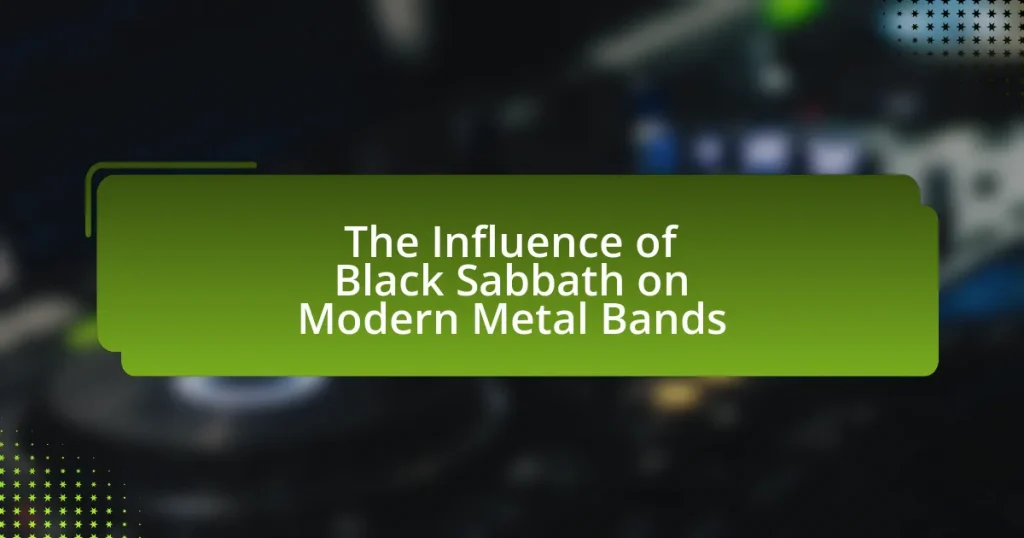Regional metal scenes are localized communities of metal music enthusiasts and bands that create and promote unique subgenres influenced by their cultural and social contexts. This article explores how these scenes differ from mainstream metal, the cultural factors that shape them, and the role of local bands in fostering community engagement and gaining international recognition. It highlights the importance of regional metal scenes in contributing to the diversity of the genre, the evolution of these scenes over time, and the strategies local bands use to connect with global audiences. Additionally, it examines notable bands making waves internationally and the collaborative efforts within regional scenes that enhance opportunities for local artists.

What are Regional Metal Scenes?
Regional metal scenes are localized communities of metal music enthusiasts and bands that create, perform, and promote metal music within specific geographic areas. These scenes often reflect the cultural, social, and musical influences of their regions, leading to unique subgenres and styles that resonate with local audiences. For example, the Scandinavian metal scene is known for its melodic death metal and black metal, while the Brazilian scene has produced a vibrant thrash metal movement. The growth of regional metal scenes can be evidenced by the emergence of local festivals, dedicated venues, and the increasing visibility of bands on global platforms, showcasing how these communities contribute to the broader metal genre.
How do Regional Metal Scenes differ from mainstream metal?
Regional metal scenes differ from mainstream metal primarily in their cultural influences and musical styles. While mainstream metal often adheres to widely accepted genres and production standards, regional scenes incorporate local traditions, languages, and themes, resulting in unique subgenres. For example, the folk metal scene in Finland blends traditional Finnish music with metal, creating a distinct sound that reflects local heritage. Additionally, regional scenes often prioritize grassroots connections, fostering community engagement and local support, which contrasts with the commercial focus of mainstream metal. This localized approach not only shapes the music but also influences the lyrical content, performance styles, and fan interactions, making regional metal a diverse and rich tapestry within the broader metal genre.
What cultural factors influence the development of Regional Metal Scenes?
Cultural factors that influence the development of regional metal scenes include local musical traditions, socio-political contexts, and community engagement. Local musical traditions shape the sound and style of metal bands, as seen in regions where indigenous music influences instrumentation and themes. Socio-political contexts, such as historical events or current issues, often inspire lyrical content and the overall message of the music, as evidenced by the rise of politically charged metal in countries facing oppression. Community engagement, through local venues, festivals, and fan interactions, fosters a supportive environment for bands to thrive, exemplified by grassroots movements that promote local talent and create a sense of identity within the metal community.
How do local traditions shape the sound of regional metal bands?
Local traditions significantly shape the sound of regional metal bands by influencing their musical styles, themes, and instrumentation. For instance, bands often incorporate traditional instruments and scales unique to their culture, which can create a distinctive sound that reflects their heritage. An example is the use of folk melodies in the music of Finnish metal bands, where elements of traditional Finnish music are blended with heavy metal, resulting in a unique subgenre known as folk metal. Additionally, lyrical themes often draw from local myths, history, and social issues, providing a cultural context that resonates with local audiences. This integration of local traditions not only enriches the music but also fosters a sense of identity and community among listeners, making the regional metal scene vibrant and diverse.
Why are Regional Metal Scenes important in the global music landscape?
Regional metal scenes are important in the global music landscape because they foster unique musical expressions and cultural identities that contribute to the diversity of the genre. These local scenes often produce innovative sounds and styles that reflect their cultural backgrounds, leading to a richer global metal community. For instance, the emergence of subgenres like Scandinavian black metal or Brazilian thrash metal showcases how regional influences shape the music. Additionally, local bands often gain international recognition, expanding their reach and influencing global trends, as seen with bands like Sepultura from Brazil and Nightwish from Finland. This cross-pollination of ideas and styles enhances the overall evolution of metal music worldwide.
What role do local bands play in promoting regional metal?
Local bands play a crucial role in promoting regional metal by serving as the primary ambassadors of the genre within their communities. They create a grassroots movement that fosters local interest and engagement through live performances, which often attract dedicated fan bases. For instance, local bands frequently organize and participate in regional festivals and events, showcasing their music alongside other acts, thereby increasing visibility for the metal scene as a whole. This local engagement is supported by statistics indicating that live music events contribute significantly to local economies, with a report from the National Endowment for the Arts highlighting that music events can boost local business revenues by up to 30%. Additionally, local bands often collaborate with one another, creating a network that strengthens the regional metal community and encourages the sharing of resources, knowledge, and audiences.
How do Regional Metal Scenes contribute to the diversity of the metal genre?
Regional metal scenes significantly contribute to the diversity of the metal genre by introducing unique cultural influences, musical styles, and lyrical themes that reflect local traditions and societal issues. For instance, Scandinavian metal often incorporates elements of folk music and mythology, while Brazilian metal may blend in rhythms from samba and bossa nova, creating distinct subgenres like folk metal and samba metal. This regional variation enriches the overall metal landscape, allowing for a broader range of sounds and expressions. Additionally, local bands often address specific cultural narratives and social issues, which resonate with their communities and expand the thematic scope of metal music globally.

Which Local Bands are Making Waves Globally?
Local bands making waves globally include Jinjer from Ukraine, known for their unique blend of metalcore and progressive metal, and Spiritbox from Canada, which has gained international acclaim for their innovative sound and powerful performances. Jinjer’s song “Pisces” has amassed millions of views on YouTube, showcasing their global reach. Spiritbox’s debut album “Eternal Blue” debuted at number 13 on the Billboard 200 chart, further solidifying their impact in the global music scene.
What characteristics define successful local metal bands?
Successful local metal bands are defined by their strong community engagement, distinctive musical style, and effective promotion strategies. Community engagement fosters a loyal fan base, as bands that actively participate in local events and collaborate with other artists tend to build stronger connections with their audience. A distinctive musical style sets a band apart in a saturated market, allowing them to carve out a unique identity that resonates with listeners. Effective promotion strategies, including social media presence and local gigs, enhance visibility and attract new fans. For instance, bands that leverage platforms like Bandcamp and Instagram to share their music and connect with fans often see increased success in local scenes.
How do these bands gain international recognition?
Bands gain international recognition through strategic use of social media, participation in global music festivals, and collaborations with international artists. Social media platforms like Instagram, Facebook, and YouTube allow bands to reach a wider audience, enabling them to share their music and engage with fans globally. For instance, bands that actively post content and interact with followers often see increased visibility and fan engagement. Participation in renowned music festivals, such as Wacken Open Air or Download Festival, exposes local bands to international audiences, enhancing their reputation and fan base. Collaborations with established international artists can also elevate a band’s profile, as these partnerships often lead to cross-promotion and access to new markets.
What strategies do local bands use to connect with global audiences?
Local bands connect with global audiences primarily through social media platforms, streaming services, and international collaborations. By leveraging platforms like Instagram, Facebook, and TikTok, bands can share their music, engage with fans, and promote their brand to a worldwide audience. Streaming services such as Spotify and Apple Music allow local bands to distribute their music globally, reaching listeners who may not have access to their live performances. Additionally, collaborating with international artists can enhance their visibility and introduce their sound to new markets. For instance, bands that have successfully utilized these strategies often see increased fan engagement and growth in their listener base, demonstrating the effectiveness of these approaches in the global music landscape.
Which regions are currently leading in producing globally recognized metal bands?
Europe and North America are currently leading in producing globally recognized metal bands. Countries such as Sweden, Finland, and Germany in Europe have a rich history of influential metal acts, including bands like Metallica, Sabaton, and Nightwish. In North America, the United States has been pivotal with iconic bands such as Slayer, Pantera, and Metallica, which have significantly shaped the genre. These regions have established vibrant metal scenes, supported by numerous festivals, dedicated venues, and a strong fan base, contributing to their prominence in the global metal landscape.
What specific bands from these regions have achieved notable success?
Notable bands from various regions that have achieved significant success include Nightwish from Finland, which has sold over 10 million records worldwide, and Sepultura from Brazil, known for their influential role in the metal genre and their Grammy nominations. Additionally, Gojira from France has gained international acclaim, with their album “Magma” reaching the top of the charts in multiple countries. These bands exemplify the global impact of regional metal scenes.
How do these bands represent their regional metal scenes on the global stage?
Bands represent their regional metal scenes on the global stage by incorporating local cultural elements into their music and performances, which helps to showcase their unique identities. For example, bands from Finland often blend traditional folk melodies with heavy metal, creating a distinct sound that reflects their heritage. This fusion not only attracts international audiences but also fosters a sense of pride within their local communities. Additionally, these bands frequently participate in global music festivals, such as Wacken Open Air in Germany, where they gain exposure and connect with fans worldwide, further amplifying their regional influences.

How do Regional Metal Scenes Evolve Over Time?
Regional metal scenes evolve over time through a combination of local cultural influences, the emergence of new subgenres, and the impact of global connectivity. Initially, regional scenes are shaped by local musical traditions and the availability of venues, which foster community engagement and support for local bands. As these bands gain recognition, they often experiment with different styles, leading to the development of unique subgenres that reflect the local culture.
For example, the rise of thrash metal in the San Francisco Bay Area during the 1980s was influenced by the punk scene and local socio-political issues, resulting in a distinct sound that resonated with the community. Additionally, advancements in technology and social media have allowed regional bands to reach global audiences, further influencing their sound and style. This connectivity enables cross-pollination of ideas and techniques, which can lead to the evolution of the scene as bands incorporate diverse influences from around the world.
Moreover, the cyclical nature of music trends often sees older bands inspiring new generations, while emerging artists bring fresh perspectives, ensuring that regional metal scenes remain dynamic and continually evolving.
What factors contribute to the evolution of a Regional Metal Scene?
The evolution of a Regional Metal Scene is primarily influenced by local culture, community support, and access to resources. Local culture shapes the musical styles and themes that resonate with audiences, while community support fosters a network of fans and musicians that encourages collaboration and growth. Access to resources, such as venues, recording studios, and promotional platforms, enables bands to produce and share their music effectively. For instance, regions with a rich history of metal music often see a higher concentration of venues and festivals, which can lead to increased visibility for local bands. Additionally, the rise of social media has allowed regional scenes to connect with global audiences, further enhancing their evolution.
How do changes in technology impact local metal bands?
Changes in technology significantly impact local metal bands by enhancing their ability to produce, distribute, and promote their music. For instance, advancements in digital audio workstations and affordable recording equipment allow bands to create high-quality recordings from home, reducing production costs and increasing accessibility. Additionally, platforms like Bandcamp and SoundCloud enable local bands to reach global audiences without the need for traditional record labels, as evidenced by the rise of independent artists who have gained substantial followings through online streaming. Furthermore, social media platforms facilitate direct engagement with fans, allowing for targeted marketing and community building, which is crucial for local bands aiming to expand their reach.
What role do social media and streaming platforms play in this evolution?
Social media and streaming platforms are crucial in the evolution of regional metal scenes by providing local bands with unprecedented access to global audiences. These platforms enable artists to share their music, engage with fans, and promote their work without the need for traditional record labels. For instance, platforms like Spotify and YouTube allow bands to distribute their music widely, while social media channels like Instagram and Facebook facilitate direct interaction with listeners, fostering community and support. According to a 2021 report by the International Federation of the Phonographic Industry, over 70% of music consumption now occurs through streaming services, highlighting their significance in shaping music trends and enabling local bands to gain international recognition.
How can local bands sustain their growth in a competitive global market?
Local bands can sustain their growth in a competitive global market by leveraging digital platforms for distribution and engagement. Utilizing social media and streaming services allows bands to reach wider audiences without the constraints of traditional marketing. For instance, platforms like Spotify and Bandcamp enable artists to distribute their music globally, while social media channels facilitate direct interaction with fans, fostering community and loyalty. According to a 2021 report by the International Federation of the Phonographic Industry, digital music revenues grew by 19.9% globally, highlighting the importance of online presence for local bands. Additionally, collaborating with other artists and participating in local and international festivals can enhance visibility and create networking opportunities, further supporting sustained growth.
What best practices can local bands adopt to thrive internationally?
Local bands can thrive internationally by leveraging digital platforms for global reach, engaging with international audiences through social media, and collaborating with artists from different regions. Utilizing platforms like Spotify and YouTube allows bands to distribute their music widely, as evidenced by the rise of artists like Babymetal, who gained international fame through online exposure. Additionally, active engagement on social media helps build a fanbase beyond local borders, as seen with bands that interact with fans worldwide, fostering a sense of community. Collaborating with international artists can also enhance visibility and credibility, as demonstrated by many successful cross-genre collaborations that have expanded audiences.
How can collaboration within the regional scene enhance opportunities for local bands?
Collaboration within the regional scene enhances opportunities for local bands by fostering networking, resource sharing, and collective promotion. When local bands collaborate, they can pool their resources, such as venues, equipment, and marketing efforts, which increases their visibility and reach. For instance, joint performances or festivals can attract larger audiences, allowing bands to showcase their music to new fans. Additionally, collaboration can lead to the sharing of best practices and knowledge, helping bands improve their craft and navigate the music industry more effectively. Research indicates that regions with strong collaborative music scenes often see a higher rate of local band success, as evidenced by the thriving music communities in cities like Seattle and Austin, where collaboration has been key to their growth.
What are the key takeaways for aspiring metal bands in regional scenes?
Aspiring metal bands in regional scenes should focus on building a strong local presence, networking with other musicians, and engaging with their community. Establishing a local fan base is crucial, as it provides the initial support needed for growth; for instance, bands like Gojira and Mastodon gained traction by performing extensively in their local areas before achieving global recognition. Networking with other musicians can lead to collaborative opportunities and shared resources, enhancing visibility and credibility. Engaging with the community through local events and social media fosters loyalty and encourages word-of-mouth promotion, which is vital for grassroots success.


